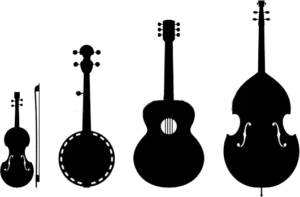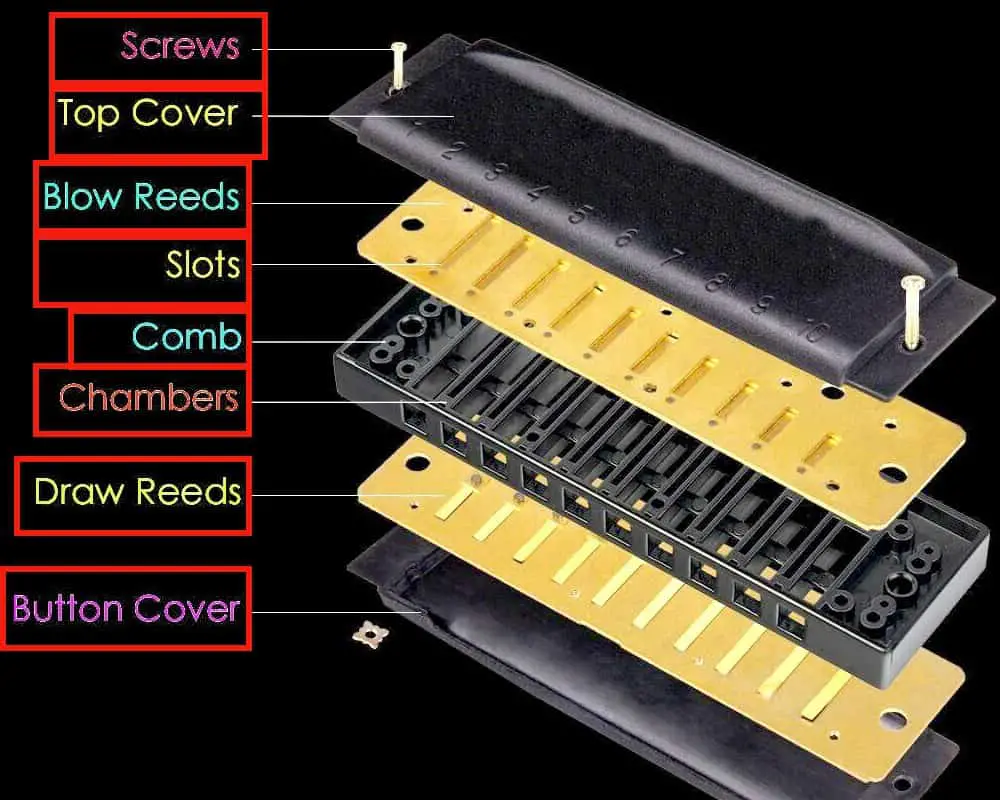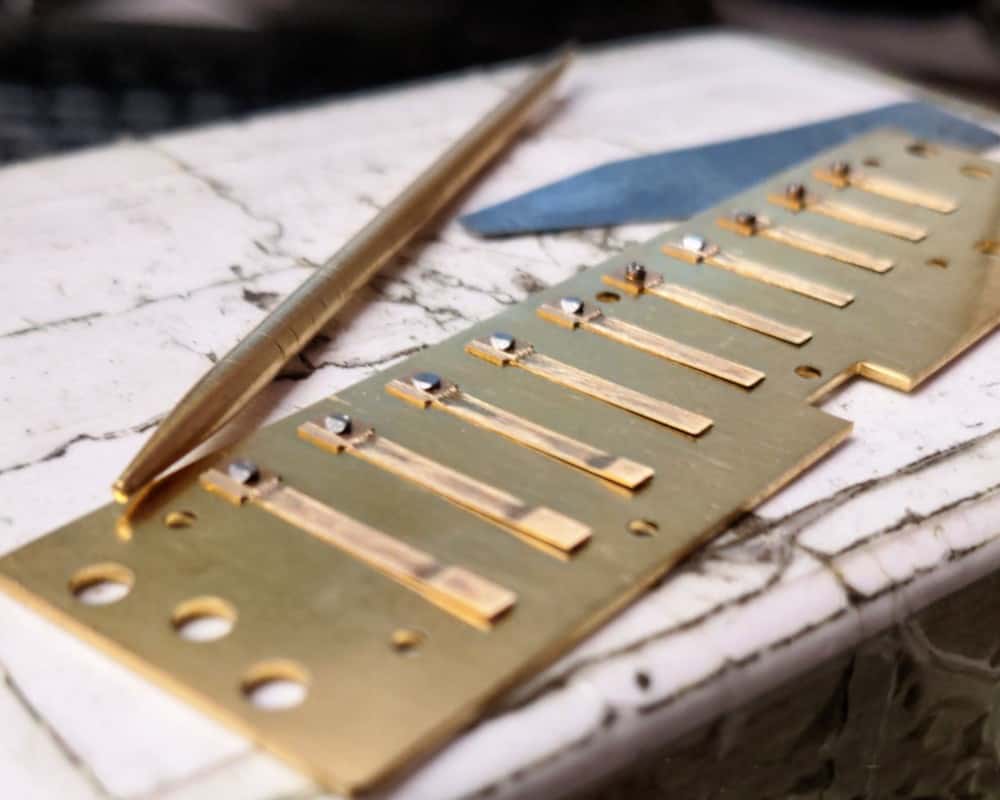When you start playing any musical instrument, you need to know what it consists of. I’ve compiled this guide about different parts of the harmonica for beginners. If you know how your instrument functions, you will get a better sound during the performance. At the end of the article, I will answer several questions you might have while reading.
If you have any questions, write them in the comments, and I will try to answer all of them.
What Is Inside of a Harmonica?
A harmonica consists of certain elements, so let’s take a look at the harmonica diagram:
- Comb
- Cover plates
- Mouthpiece
- Reeds
- Reed plates
- Rivets
- Slider mechanism button
- Windsavers
- Body
I will tell you about the nine components of the harmonica here. Some components are present only in certain harmonicas, so check the description of the item before buying it.
Comb
A comb is the main part of any harmonica. It enables you to play sounds. By moving the harmonica, you can produce both higher and lower notes. It can be made of metal, plastic, or wood. The comb is a nozzle with holes through which you blow air. This way, you produce sounds. Wooden combs are susceptible to moisture and can deteriorate, but there are closed combs that do not get wet. Metal options are the most durable. The peculiarity of wooden combs is that they provide you with a softer tone.
Cover plates
The upper part of the harmonica is the lining that protects the reeds and reed plates. Although the pads protect the reeds, they are made so that air can pass through. Linings can be made of different metals that are resistant to corrosion and rust. There are many cover plates on the market that can improve ergonomics and sound quality, according to some musical experts.
Mouthpiece
This is the front part of the harmonica, which has holes in it. The mouthpiece is located only on chromatic harmonicas. You can choose either chrome or gold-plated mouthpieces, depending on your budget. The slider mechanism is situated behind the mouthpiece.
Reeds
The reeds are what make the music. That is, they produce the notes. Reeds are made of brass, stainless steel, or bronze. Brass is most commonly found in harmonicas, which is why such models are cheaper. Brass produces softer sounds because the material is soft.
Bronze produces a brighter sound than brass. Stainless steel is most often used in expensive models. The reeds made of stainless steel have a similar sound to brass and are more durable than others. Reeds are factory-tuned, but if they fail, you can readjust them in specialized workshops.
Reed plates
Reed plates are made of brass; they are thinner and have a square shape. These inserts contain holes for certain reeds. In addition, reed plates are screwed on. They are often used in high-quality harmonicas, and experts say they are among the best on the market.
Rivets
This is another type of plate. These plates have the reeds attached to them, which has given them their name. Such plates are considered the most reliable because they do not break for a long time. When choosing a harmonica, ensure there are screwed reed plates. Due to them, you will not have to repair your instrument at the very start.
Slider mechanism button
This part of the harmonica is present only in chrome-plated models. It is activated by pressing the button at the end of the harmonica. The slider button helps to access sharps and flats. If this slider is pressed, air will go to the second row of reeds. These reeds are already tuned to certain notes. Pressing the slider raises the key by 1. This way, you can achieve a different sound, which is possible only on chrome harmonicas.
Windsavers
This component is also present in chromatic harmonicas. These flaps cover a part of the harmonica, making it more airtight. Windsavers also cover the reeds. Such protection ensures the tool’s safety and durability. It helps your harmonica withstand wind and draft. When choosing a chrome harmonica, pay attention to this detail, as it will secure your instrument.
Body
The body is the basis of the harmonica. The reeds that create the sound are attached to it. The body can be made from various materials, such as plastic, metal, or wood. The price of the harmonica depends on the material used. The wooden case is mostly made of a pear, so this material is popular on the market.

FAQ About Harmonica Parts
In this section, I will answer some questions you might have while reading the article. By reading the answers, you can learn the nuances of the topic and understand it better.
What are the reeds of harmonica made of?
The reeds are usually made of brass, bronze, or stainless steel. Cheaper models are made from brass and more expensive—from stainless steel. The sound depends on the metal used, and the tone can be softer or brighter.
What are the different types of combs used in harmonicas?
Combs can be made from different materials, such as wood, plastic, or metal. Wood can absorb odors and microbes, which is why it is the most short-lived. It is best to use metal combs. They are the most durable ones but also expensive.
How long do harmonica reeds last?
The reeds last for about six months. If you use a harmonica with wooden reeds, you might need to repair your instrument more often. Metal reeds last longer. That’s why it’s important to buy a quality instrument.

Not That Complicated as It Might Have Seemed
As you can see, a harmonica consists of numerous elements that complement each other. Harmonicas’ components can differ, which affects the model price. The most expensive and durable option has a metal case and stainless steel reeds. Which kind of harmonica do you want to buy? Have you already tried your hand at playing the harmonica? Share your thoughts in the comments.
Also Read:


